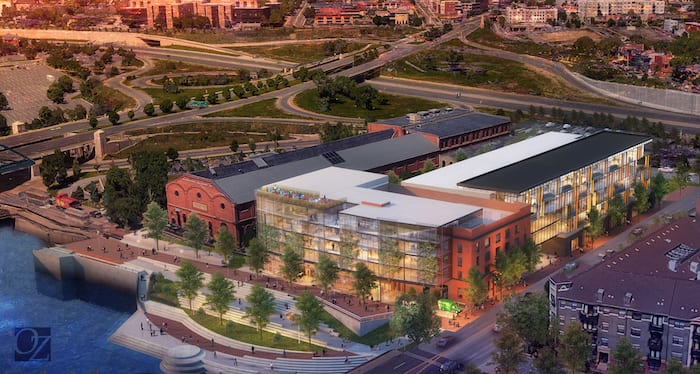Pandemic Sparks Push for Safer Office Builds

BUILDING DIALOGUE
WORDS: Kevin Criss
Colorado’s developers and architects normally design office buildings to be resilient in the face floods, fires and those seemingly ever-changing tenant tastes. And while the desire for office spaces that minimize germ/bacteria/virus transfer has been batted around in cli ent meetings for years, most of the practices rarely, if ever, made it into the final design.
Until now.
COVID-19 has pushed safe building practices to the forefront and sparked new dialogue on just how to improve tenant safety.
“It reflects how everybody’s life is changing,” says Aldo Sebben, principal at STUDIO Architecture. “A virus like this shows the risks involved and up until now that hasn’t really been the focus of office building design. Our office building owners and their tenants are now looking much more closely at how they can protect their workforce.”
“As stewards of the build environment, it’s our responsibility to come up with ways that will allow people to utilize office buildings and common spaces in a way that is safe, effective and efficient,” says Amanda Johnson, LEED AP at OZ Architecture. “And it’s our social responsibility to craft ways for that to happen.”
Both Sebben and Johnson say that in the last few months clients have approached them looking for ways to make their office projects healthier for the tenants.
“It’s something we’re addressing right now on an office project in downtown Boulder,” says Sebben. “The client requested healthier build options and we’re delivering that.”
“We’ve seen it on a handful of projects that we’re working on, but most notably a large office building on the Confluence,” says Johnson. “That owner said to us, ‘I want to create the healthiest building in Denver.’ So, it challenged us to not only look at systems, but also vertical circulation, organization of the common spaces and elevators, as well as the path of travel from your car to your suite.”
Areas of Focus
A study published by the American Society for Microbiology found that a single contaminated office tabletop or doorknob can spread to 40%-60% of workers and visitors within two to four hours. When it’s the common cold, its productivity loss. When it’s a deadly virus, the stakes are higher.
For STUDIO’s clients, Sebben and his team compiled an extensive list of “COVID-19 Building Strategies” that covered seemingly every design option in architecture, HVAC, plumbing and electrical, including:
• Space Planning
• Main Entry and Elevators
• Restrooms
• Water Fountains
• Mechanical Systems
• Lighting
Dr. Eric Poeschla, head of infectious diseases at the University of Colorado School of Medicine, believes architects, developers and builders should focus on increasing open areas, improved ventilation, increased humidity and hands-free devices and fixtures.
“With respiratory viruses like this, they’re spread when there’s a closed area without much ventilation, which allows droplets and aerosols to build up,” says Dr. Poeschla. “So, increased ventilation is very good, as is improved humidity. Low humidity in the office can be destructive to our mucous membranes. It dries them out and decreases airway defenses. Proper building humidification, I think, is one of the central things that (architects and developers) should pay attention to.”
But, when it comes to infrared fever screening, currently being touted by many politicians and pundits as a safe reopening tactic, Dr. Poeschla is not a fan. “In fact, it doesn’t do anything. You have a problem with false readings, and even if you were to pick up a fever, what are you going to do, throw the person out of the building on the spot? Especially when you could’ve detected the illness through a simple questionnaire. I wouldn’t recommend it for many reasons.
“What we worry about are door handles, elevator buttons, things like that. The real issue is trying to have touchless things. Automatic door openers are a good way to go so, again, I would emphasize eliminating high touch surfaces, increased ventilation and proper humidification.”
Hybrid Working Model
For its clients, OZ has created something it calls the “Hybrid Working Model,” which helps them determine the needs of clients, now and in the future.
“This Hybrid Working Model allows us to talk to our clients about how they use the office and how their teams use the office in an effort to understand how the office is going to be used in the future,” says Johnson. “For some, it might mean that their office is 50% larger because they need to be in the office most of the time. And they need people to be spatially organized in a way that they can feel safe in their work environment. And others might be more inclined to downsize their footprint. So, it’s a really interesting dialogue we’re having with our clients in rethinking program flexibility.”
COVID-19 has created a new world that we all must navigate. Moving forward, Colorado’s architects, developers and builders are creating new ways to work in that world safely and efficiently.
“This is going to alter the way we all live and work,” says Sebben. “There’s a new normal that will come out of it.
Published in the September 2020 issue of Building Dialogue.













